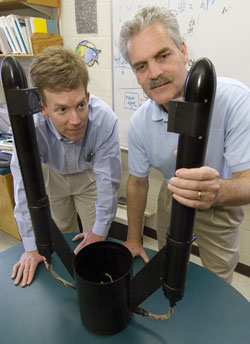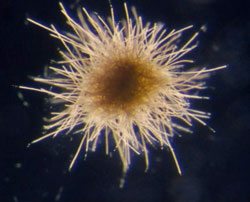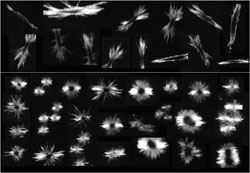Towing an underwater video microscope across the Atlantic Ocean, two scientists found unexpected abundances of colonial cyanobacteria that fertilize the oceans with nitrogen. The bacteria may turn out to be “a crucial component” that stimulates the growth of plants and animals in vast ocean regions that might otherwise be nearly barren, they reported in the June 9, 2006, issue of the journal Science. Just like plants on land, microscopic marine plants at the base of the food chain require nitrogen to grow. But the source of nitrogen, especially in the open ocean far from coastal waters fed by runoff from rivers and land, “represents one of the most intriguing conundrums in oceanography,” Zbigniew Kolber, a research engineer at Monterey Bay Aquarium Research Institute, wrote in Science. Two scientists at Woods Hole Oceanographic Institution (WHOI) “decided to have another ‘look’ at this problem, literally,” he wrote. Cabell Davis of the Biology Department and Dennis McGillicuddy of the Applied Ocean Physics and Engineering Department towed a device called the Video Plankton Recorder (VPR) behind the WHOI-operated research vessel Knorr from the Azores almost back to Woods Hole. It remained in the water 24 hours a day, taking digital photographs 30 times per seconds as it undulated from the surface to depths of 425 feet (130 meters). “It was the VPR’s longest tow, more than 5,500 kilometers (nearly 3,000 nautical miles), but slow—like driving a lawnmower across country at 12 knots,” Davis said. The VPR images showed unexpected widespread populations of Trichodesmium, bacteria that were formerly (and inaccrately) known as blue-green algae. They form tiny colonies of golden-brown spiky balls (called “puffs”) or reddish rafts (called “tufts”). The fragile colonies, 1 to 3 millimeters in diameter, are visible to the eye, but are not easy to collect or count because they tend to break apart when handled. The VPR gave scientists the ability to look observe and count Trichodesmium in a non-invasive way. Davis and McGillicuddy found that Trichodesmium live not only at the surface, as scientists previously thought, but throughout the region where light penetrates the ocean. They estimated that Trichodesmium were two to three times more abundant than previously believed. “If traditional sampling has underestimated colonies in other regions of the world, estimates of global Trichodesmium abundance will increase dramatically, changing our perception of the importance of this organism to the productivity of the world ocean,” Davis said. In July, Davis and McGillicuddy towed the VPR behind Knorr to survey Trichodesmium abundance, this time through the Caribbean Sea. The project was supported by the Richard B. Sellars Endowed Research Fund, the Andrew W. Mellon Foundation Endowed Fund for Innovative Research, the WHOI Ocean Life Institute, the National Science Foundation, and the National Aeronautics and Space Administration. Originally published: July 25, 2006 Last updated: August 28, 2013 | |||||||||||||||||||||||||||||||
Copyright ©2007 Woods Hole Oceanographic Institution, All Rights Reserved, Privacy Policy. | |||||||||||||||||||||||||||||||




